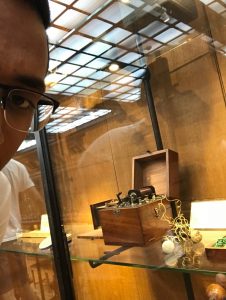This week my Neuroscience class visited the Museum on the History of Medicine. The experience was extraordinary– I learned how medical techniques have transformed over the course of human history. Each technological evolution explored the human body in a novel way and challenged our understanding of physiology and disease.
Some parts of the exhibit were grotesque- replete with bone saws, human tables, and blunt skull drills. Others were awe-inspiring in how surgeons had found unique ways to battle different kinds of diseases and afflictions. One device that had captivated our entire class was an electric shocking device from the late 1800’s. The device would deliver an electric current to patients with depression. As our guide explained the nature of the invention, an almost audible gasp came from our class. We had all read about the medical torture that the mentally ill had gone through in the last few centuries. For many in our class, this device embodied the poor medical understanding medicine has had of mental disease. I, on the other hand, was shocked at how right the inventors of this device had been.

Over the last two years, depression research has been an important part of my life. I have had the pleasure of working under Dr. Helen Mayberg, a doctor researching the application of Deep Brain Stimulation (DBS) in treatment-refractory depression. DBS is a medical technique that was previously used in the treatment of late-stage Parkinson’s disease.
Many researchers believe mental illness also has its roots in physical problems in the brain as well. Over the last few decades, researchers have been looking specifically at “neurocircuitry,” or the electrical highways that connect major brain regions. Dr. Mayberg believes that many crucial emotional brain circuits cross at an area called BA 25 (Mayberg, 2009).

She maintains that by giving an electric current in BA 25, doctors can alleviate depression in people where drugs failed. Listening to lab meetings, I had always wondered how the idea of electrically shocking the brain to cure illness had come to be. Now, standing in front of some of the first devices to attempt this, I was shocked by the insight of previous doctors. While crude and non-specific, the inventors of this device had a revolutionary understanding of how our brain worked.

I hope to be a doctor that challenges our understanding of the human body and its workings. This visit inspired me to want to be involved at the frontier of medical research in the future.
link: https://med.emory.edu/gamechangers/research/mayberg/pdfs/6-Mayberg-JCI-April09.pdf
